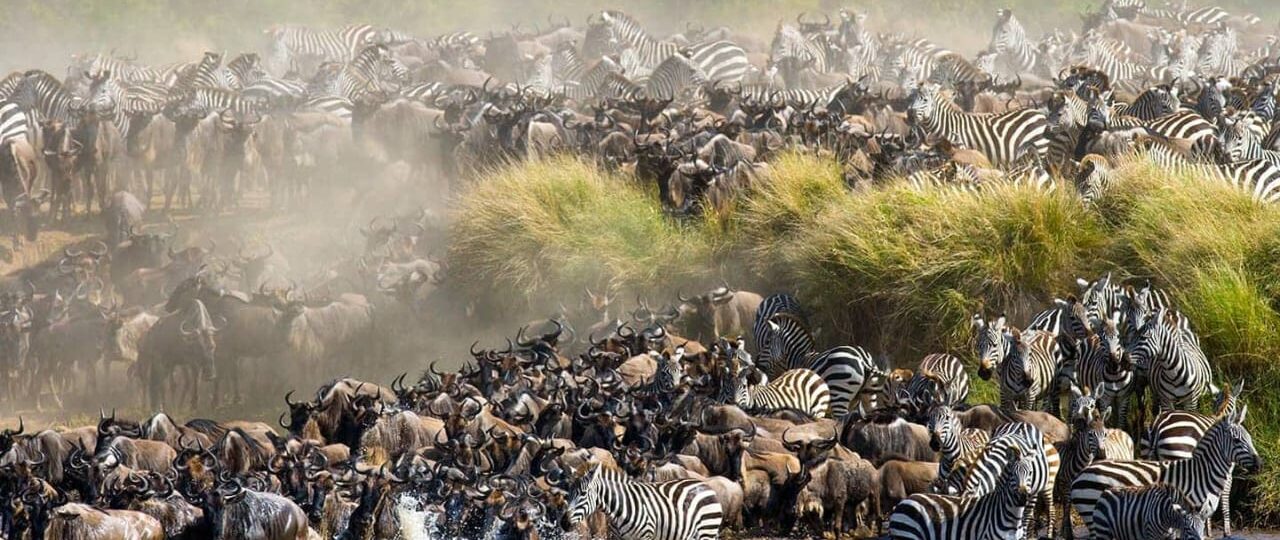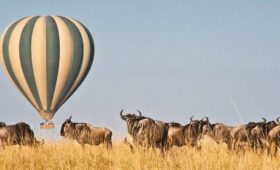The Greatest Show on Earth: Masai Mara’s Wildebeest Migration
Every year, deep in the heart of East Africa, a breathtaking phenomenon unfolds — the Great Wildebeest Migration across the Masai Mara. It is a spectacle of survival, endurance, and instinct; a dramatic and relentless journey that has earned its place among the greatest natural wonders of the world.
A Journey Written in Dust and Blood.
The migration is not merely a movement of animals. It is an ancient rhythm, a living pulse that beats through the plains of the Serengeti in Tanzania and northward into Kenya’s Masai Mara. Over 1.5 million wildebeests, joined by zebras, gazelles, and elands, travel hundreds of kilometers in a continuous search for greener pastures and life-sustaining water.
The journey is perilous. Every step brings new challenges: raging rivers, stealthy predators, and the brutal forces of nature itself. Yet the wildebeests, driven by instinct older than memory, move as one, painting the landscape in a moving sea of dust and life.
The Drama of the Mara River.
One of the most iconic moments of the migration is the Mara River crossing. Here, life and death hang in delicate balance.
On the river’s edge, the herds gather, restless and jittery. Their low, constant murmurs create a nervous hum that fills the heavy air. They sense the danger lurking beneath the river’s muddy waters — massive Nile crocodiles lying in wait, still as fallen logs.
Suddenly, one wildebeest leaps into the river. Then another. Then thousands. The scene explodes into chaos. Powerful limbs thrash against the current. Calves cry for their mothers. Some make it across; others are dragged down, swallowed by the merciless water or the waiting jaws beneath.
It is brutal. It is heart-wrenching. And it is a vital thread in the endless cycle of life on the savannah.
A Living Canvas of Predators and Prey
Beyond the river, the endless grasslands of the Masai Mara stretch into the horizon. Here, the drama continues. The herds graze, regain their strength — but they are never truly safe.
Lions, with their golden eyes and silent paws, stalk the edges of the herds. Cheetahs flash across the open plains, chasing down the young and the weak with astonishing speed. Hyenas and wild dogs follow, ready to seize any opportunity left behind by the larger predators.
The migration fuels the entire ecosystem, feeding not only the herbivores who find new grazing but also the predators who rely on the abundance of prey.
The Human Connection.
The Maasai people, traditional custodians of this land, live in harmony with the migration. Their red shukas (cloths) flutter like flags against the endless gold of the plains. They have shared these lands with the migrating herds for centuries. Understanding the rhythms of nature with an intimacy few others can claim.
For visitors, witnessing the Great Migration is transformative. Standing under the vast African sky, watching the endless line of wildebeests march into the horizon, one feels a deep, almost primal connection to the Earth.
When and How to Witness the Migration
The best time to experience the river crossings in the Masai Mara is between July and October, when the herds surge into Kenya from the Serengeti.
However, the migration is a year-round cycle. Even outside the dramatic crossings, visitors can witness calving season in the Serengeti (January – March), predator action, and massive herd movements across the plains.
Safaris tailored to the migration often include mobile camps that move with the herds, offering front-row seats to one of nature’s greatest dramas.
Why the Masai Mara?
The Masai Mara offers not just a view of the migration but an immersion into a world that feels eternal. Wide-open spaces, thundering herds, majestic predators, and the vibrant culture of the Maasai combine to create an experience that lingers long after the dust of the savannah has settled.
To watch the Great Migration is not just to witness an animal movement — it is to feel the heartbeat of Africa itself.



